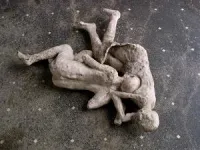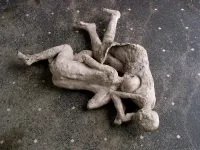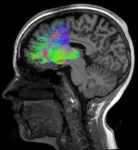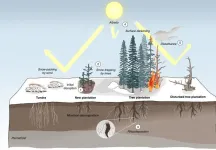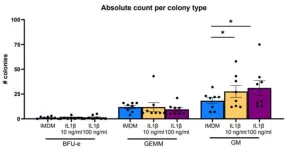(Press-News.org)
In 79 AD, Mount Vesuvius experienced one of its most significant eruptions, burying the Roman city of Pompeii and its inhabitants under a thick layer of small stones and ash known as lapilli. Many of Pompeii's inhabitants lost their lives as their homes collapsed under the weight of the lapilli raining down from many kilometres above. Those who survived the initial phase of the eruption eventually succumbed to the dangerous pyroclastic flows. This fast-moving stream of hot gas and volcanic matter instantly enveloped their bodies in a solid layer of ash, effectively preserving their bodies, including their features.
Since the 1800s, casts had been made by pouring plaster into the voids left by these bodies after their decay. The research team extracted DNA from the heavily fragmented skeletal remains embedded in 14 of the 86 famous casts undergoing restoration. This extraction process allowed them to accurately establish genetic relationships, determine sex and trace ancestry. Interestingly, their findings largely contradicted previous assumptions based solely on physical appearance and the positioning of the casts.
Genetic relationships of victims revisited
"This research shows how genetic analysis can significantly add to the stories constructed from archaeological data“, says Professor David Caramelli, from the Department of Anthropology at the University of Florence. "The findings challenge enduring notions such as the association of jewellery with femininity or the interpretation of physical proximity as evidence of familial relationships.“ "Moreover," Caramelli adds, "the genetic evidence adds a layer of complexity to simple kinship narratives. For example, in the House of the Golden Bracelet, the only site where we have genetic information from multiple individuals, the four people traditionally thought to be the two parents and their children actually have no genetic ties to each other".
“The scientific data we provide do not always align with common assumptions,” says David Reich of Harvard University. “For instance, one notable example is the discovery that an adult wearing a golden bracelet and holding a child, traditionally interpreted as a mother and child, were an unrelated adult male and child. Similarly, a pair of individuals thought to be sisters, or mother and daughter, were found to include at least one genetic male. These findings challenge traditional gender and familial assumptions.”
Cosmopolitan nature of the Roman Empire
The genetic data also provided information about the ancestry of the Pompeians, who had different genomic backgrounds. The finding that they were mainly descended from recent immigrants from the eastern Mediterranean highlights the cosmopolitan nature of the Roman Empire.
“Our findings have significant implications for the interpretation of archaeological data and the understanding of ancient societies,” says Alissa Mittnik of the Max Planck Institute for Evolutionary Anthropology. “They highlight the importance of integrating genetic data with archaeological and historical information to avoid misinterpretations based on modern assumptions. This study also underscores the diverse and cosmopolitan nature of Pompeii’s population, reflecting broader patterns of mobility and cultural exchange in the Roman Empire.”
"It is also likely that the use of these casts for narration purposes could have led to past restorers modifying their postures and placements", adds David Caramelli. "The combined use of genetic data and other bioarchaeological methods provides us with the chance to better comprehend the lives and habits of the victims of the Vesuvius eruption."
Gabriel Zuchtriegel, Director of the Pompeii Park, says, "The Pompeii Park has been including ancient DNA analysis in its study protocols for years, not only for human victims, but also for animal victims.“ He explains that the Park manages a variety of research projects through its own laboratory. These include isotopic analysis, diagnostics, geology, volcanology and, in particular, reverse engineering. He stresses that "all these elements together contribute to a comprehensive, updated interpretation of the archaeological findings. These efforts are turning Pompeii into a veritable incubator for the development of new methods, resources and scientific comparisons". Zuchtriegel concludes: "From this point of view, this study marks a true change in perspective, in which the site itself plays a central role in advancing archaeology and research."
END
In 79 CE, the active volcanic system in southern Italy known as Somma-Vesuvius erupted, burying the small Roman town of Pompeii and everyone in it. The “Pompeii eruption” covered everything in a layer of ash that preserved many of the bodies. Now, ancient DNA collected from the famed body casts alters the history that’s been written since the once forgotten town’s rediscovery in the 1700s. As reported on November 7, 2024, in Current Biology, the DNA evidence shows that individuals’ sexes and family relationships don’t match ...
Scientists have known for decades that the classic symptoms of schizophrenia, such as jumping to conclusions or difficulty adjusting to new information, can be attributed to poor communication between the cerebral cortex and the thalamus, known as the brain’s central switchboard. By measuring brain cell activity between these two regions as volunteers completed ambiguous tasks, a team of Tufts University School of Medicine and Vanderbilt University School of Medicine researchers found a way to use someone’s sensitivity to uncertainty as a diagnostic tool.
In a study published November 7 in the journal ...
Annual emissions of carbon dioxide (CO2) from private aviation increased by 46% between 2019 and 2023, according to an analysis published in Communications Earth & Environment. The results also show that some individuals who regularly use private aviation may produce almost 500 times more CO2 in a year than the average individual, and that there were significant emissions peaks around certain international events, including COP 28 and the 2022 FIFA World Cup.
Private aviation is highly energy-intensive, emitting significantly more CO2 per passenger than commercial flights, but is used by approximately 0.003% ...
Tree planting has been widely touted as a cost-effective way of reducing global warming, due to trees’ ability to store large quantities of carbon from the atmosphere. But, writing in the journal Nature Geoscience, an international group of scientists argue that tree planting at high latitudes will accelerate, rather than decelerate, global warming.
As the climate continues to warm, trees can be planted further and further north, and large-scale tree-planting projects in the Arctic have been championed by governments and ...
Genes contain instructions for making proteins, and a central dogma of biology is that this information flows from DNA to RNA to proteins. But only two percent of the human genome actually encodes proteins; the function of the remaining 98 percent remains largely unknown.
One pressing problem in human genetics is to understand what these regions of the genome do—if anything at all. Historically, some have even referred to these regions as “junk.”
Now, a new study in Cell finds that some noncoding RNAs are not, in fact, junk—they are functional and play an important role in our cells, including in cancer and human development. Using CRISPR technology that ...
About The Study: In this longitudinal cohort study of multiple aspects of child neurodevelopment between ages 6 and 24 months, negligible associations between prenatal exposure to SARS-CoV-2 infection and child outcomes were observed. Follow-up research is warranted to determine whether these predominantly null effects persist into later childhood.
Corresponding Author: To contact the corresponding author, Gerald F. Giesbrecht, PhD, email ggiesbre@ucalgary.ca.
To access the embargoed study: Visit our For The Media website at this link https://media.jamanetwork.com/
(doi:10.1001/jamanetworkopen.2024.43697)
Editor’s ...
About The Study: Results from this study highlight a lower genetic detection rate for Black patients than for white patients with inherited retinal diseases. This supports a concern that the current development of inherited retinal disease therapeutics is highly dependent on the ability to identify the genetic cause of disease.
Corresponding Author: To contact the corresponding author, K. Thiran Jayasundera, M.D., email thiran@med.umich.edu.
To access the embargoed study: Visit our For The Media website at this link https://media.jamanetwork.com/
(doi:10.1001/jamaophthalmol.2024.4696)
Editor’s Note: Please see the article for additional information, including ...
When thinking about the immune system, most people think about B and T cells and how they can be trained to recognize pathogens, preventing re-infections. Besides this “adaptive” immune system, we also have an “innate” immune system which acts as first line defense against e.g. bacteria and viruses. The textbook view is that the innate immune system is non-specific so that it’s response always follows the same pattern, even for recurring infections. However, research published today in Stem Cell Reports provides evidence ...
“It’s necessary to consider the full life cycle of plastics, starting from the extraction of fossil fuel and the primary plastic polymer production” says lead article writer Patricia Villarrubia-Gómez at Stockholm Resilience Centre.
Plastics are not as safe and inert as previously thought. The new research article written by an international team of researchers uses the planetary boundaries framework to structure the rapidly mounting evidence of the effects of plastics on the environment, health and human wellbeing.
500 million tons of plastics are now produced yearly but only nine percent get recycled globally. Plastics are everywhere: ...
The risks of adverse effects and complications from treatment for prostate cancer are substantial and continue for years after treatment ends. The largest comprehensive analysis reporting long-term risks from such treatment relative to the risks faced by a control group of untreated men has just been published in the journal JAMA Oncology.
In the 12 years following treatment, men whose initial treatment was a prostatectomy (removal of all or part of the prostate) had a risk of urinary or sexual complications ...

